Marc Leepson's Blog, page 10
December 6, 2018
November 2018
Saving Monticello: The NewsletterThe latest about the book, author events, and moreNewsletter Editor - Marc Leepson
Volume XV, Number 11 November 1, 2018
“The study of the past is a constantly evolving, never-ending journey of discovery.” – Eric Foner
THE STATUE AND THE MAN: Two weeks ago the Washington Post’s John Kelly, who writes a popular column on historical matters of local interest, told the tale of the statue of Thomas Jefferson that Uriah Levy commissioned in 1833 and presented to the United States—the one that now stands in the Rotunda in the U.S. Capitol.
How the statue got there is a complicated (and fascinating) story, and one I tell in detail in Saving Monticello.
I noticed a minor error in a quote Kelly used—that Levy rose to the rank of Captain in the Navy; in fact, he was a Commodore when he died in service in 1862. So I emailed Kelly, telling him I read the column with interest, and pointing out the misstatement.
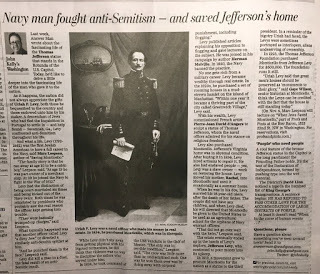
He emailed me right back and asked if I would fill him in on Uriah Levy’s life and Navy career. I accepted in a New York minute and the next day we had a great 45-minute talk.
To my delight, the following Sunday, October 28, Kelly devoted his column to Levy, highlighting his Navy career, including the anti-Semitism he faced, his six courts-martial (mostly on trumped-up charges), and how he spearheaded the successful effort to ban flogging in the Navy. Kelly also touched on the statue and how UPL and his nephew Jefferson M. Levy saved Monticello.
The column ended with a quote from Gaye Wilson, senior historian at Monticello’s Robert H. Smith International Center for Jefferson Studies—a quote that I completely agree with.
Uriah Levy, she told Kelly, “said that great men’s homes should be preserved as ‘monuments to their glory.’ I think the Levys can be credited with the fact that the house is still standing today.”Here’s the link to Kelly’s column: http://bit.ly/Kellycolumn

SEPHARDI IDEAS: As readers of Saving Monticello know, Uriah Levy and Jefferson M. Levy (who owned Monticello from 1834-1923) are descended from Sephardic Jews who fled the Inquisition in Portugal, and in 1733 helped found the city of Savannah, Georgia. The magazine Sephardi Ideas Monthly ran a long interview with me that covered the family’s escape from Portugal and Uriah and Jefferson Levy’s stewardship of Monticello in the October issue of the magazine, which features “essays from the rich, multi-dimensional world of Sephardi thought.”
You can read the entire article on line at http://bit.ly/SephardiIdeas
EVENTS: Here are my November events:· On Saturday, November 3, I will be doing a talk on Ballad of the Green Beret for the Freedom Hill DAR chapter’s monthly meeting in McLean, Virginia· I’ll be speaking about Saving Monticello on Sunday, November 4, at the Bier Baron Tavern in Washington, D.C., as part of the Pints and Profs program (current and former college profs speaking at bar/restaurants in D.C.), starting at 6:00. Ticket info at profsandpints.com
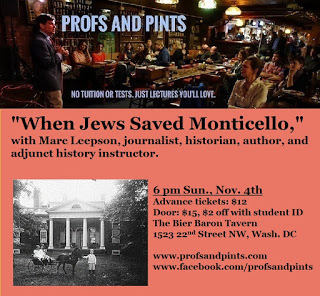
· On Tuesday, November 6, I’ll be speaking about Saving Monticello at the monthly meeting of The Madisons of Montpelier Daughters of 1812 chapter in Gordonsville, Virginia. · At the monthly meeting of the Anne Marie Fitzhugh chapter on Saturday, November 10, in Springfield, Virginia, I’ll present a talk on my Francis Scott Key biography, What So Proudly We Hailed.
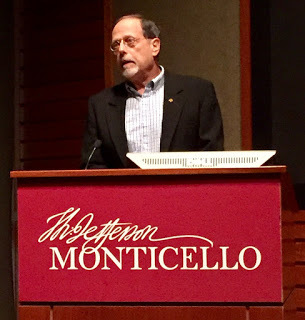
If you’d like to arrange an event for Saving Monticello or for any of my other books, please email me at marcleepson@gmail.com
For info on my latest book, Ballad of the Green Beret, please go to http://bit.ly/GreenBeretBook For details on other upcoming events, go to http://leepsoncalendar.blogspot.com
GIFT IDEAS: Want a personally autographed, brand-new paperback copy of Saving Monticello? Please e-mail me at marcleepson@gmail.com I also have a few as-new, unopened hardcover copies, along with a good selection of brand-new copies of my other books: Flag: An American Biography; Desperate Engagement; What So Proudly We Hailed: Francis Scott Key, a Life; and Ballad of the Green Beret: The Life and Wars of Staff Sgt. Barry Sadler.
Published on December 06, 2018 13:07
October 4, 2018
October 2018
Saving Monticello: The NewsletterThe latest about the book, author events, and moreNewsletter Editor - Marc Leepson
Volume XV, Number 10 October 1, 2018
“The study of the past is a constantly evolving, never-ending journey of discovery.” – Eric Foner
‘ALSO AT MONTICELLO’: While doing research for my next book—another history of an important American house (details to come later)—I came across a document I’d never seen: Jefferson Monroe Levy 1897 passport application.
I knew Jefferson Levy had to have had a passport because, as I wrote in Saving Monticello, he made many trips abroad—primarily to England and France—after he’d made a fortune in real estate and stocks in the mid-1890’s.
Aside the satisfaction of adding the application to my Saving Monticellofiles, it was interesting (and illuminating) to read what Levy wrote in the application about where he lived. To wit: he was “now residing at 66 East 34thStreet in the city of New York, and also at Monticello, Virginia.”
I also found it interesting that Levy wrote that his late father, Jonas Levy (Uriah Levy’s brother) was born in New York City and was a citizen of the United States, and then added the words, “born in Philadelphia.” Here’s the entire application as it appears on ancestry.com:
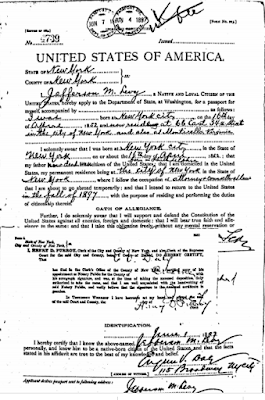
PRESIDENT CLEVELAND (con’t.) The folks at Monticello were pleased to learn that, as I wrote in last month’s newsletter, a second president—Grover Cleveland—had paid a visit during the Levys’ ownership. Until I found a recently digitized Washington Post article detailing that July 1888 occasion, the only presidential visit we knew about was a 1903 trip up the mountain (on horseback) by President Theodore Roosevelt.
In the W.P. article, the reporter noted that Cleveland, who was not svelte, decided not to climb up a short incline to pay his respects at Jefferson’s grave site. Cleveland, instead, sat in his carriage for a few minutes peering up at the obelisk marking Jefferson’s grave, then ordered his driver to move up to the house. I used the modern-day photo on the right to illustrate the site that Cleveland saw.
Bill Bergen, the outstanding Monticello guide, found a Cleveland-era photo of the same spot (below), and kindly sent it to me.
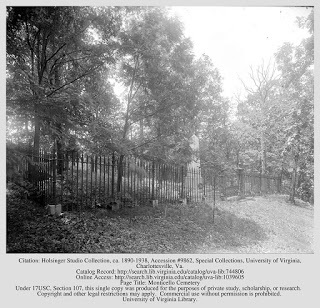
This more accurately shows what Cleveland saw that day—that is, that there were no steps. So he would have had to make his way up the small embankment in the rain, another probable reason why he decided not to get out of the carriage.
SEPTEMBER 20: I had a memorable day at Monticello on Thursday, September 20. My wife Janna and I drove up to the Mountain around 12:30 that afternoon, and took a 1:15 tour of the house, led by the great guide, Bill Bergen. We learned many things, and Bill kindly allowed me to add a few thoughts about Jefferson Levy during his concluding remarks to the tour group outside on the portico. That’s Bill with me after the tour.
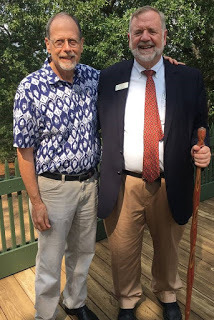
After the tour we took in the new Sally Hemings exhibit—a short but moving, enlightening and brilliantly executed multi-media experience. After that, we went back down to the Visitors Center for a quick lunch at the café, and then I signed books at the Gift Shop. Folks who were attending the evening’s reception for Monticello donors started coming in and I was happy to sign books and talk to them.
We then drove back up to a parking lot near the house and walked over to the tent on the lawn where I did a sound check and the IT folks got my PowerPoint set up. Then back into the house where I sat down in one of the upstairs rooms for a video interview that the Foundation will be using on social media and for marketing.
We were back out on the lawn at 6:00 for the reception before the program. There was plenty of food—of the heavy hors d’oeuvre variety—and beverages. I opted for water as it was a muggy evening. I talked to a bunch of friendly people, including two Jefferson descendants, several guides, and other Monticello staffers.
Luckily, the rain that threatened did not materialize.
The program began at 7:00 with welcoming remarks from Leslie Bowman, who heads the Thomas Jefferson Foundation. Susan Stein, Monticello’s long-time curator whom I have known and admired and worked with for nearly twenty-five years, spoke a bit about the Levys, and then gave me the best introduction I’ve ever had—and I’ve had more than a few over the years.
Then it was up to me to tell the story of the Levys and Monticello to around seven hundred people. My allotted half hour sped by. There were good questions from the audience, and more than a few folks came up to me afterward to chat. We left at around 9:00. A long, great day.
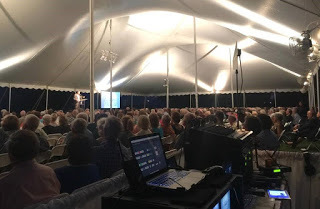
Special thanks to Leslie Bowman, Susan Stein and Mary Scott-Fleming, who did the logistical arrangements.
EVENTS: Just one for me in October. On Tuesday, Oct. 16, I’ll be doing a talk on Saving Monticello in Norfolk for the Colonial Dames Tidewater Chapter.
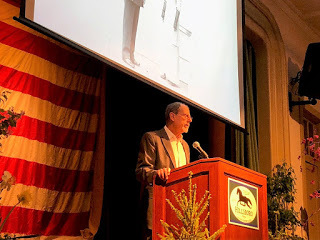
If you’d like to arrange an event for Saving Monticello—or for any of my other books, including Ballad of the Green Beret—please email me at marcleepson@gmail.com
For info on my latest book, Ballad of the Green Beret, please go to http://bit.ly/GreenBeretBook For details on other upcoming events, go to http://leepsoncalendar.blogspot.com
GIFT IDEAS: Want a personally autographed, brand-new paperback copy of Saving Monticello? Please e-mail me at marcleepson@gmail.com I also have a few as-new, unopened hardcover copies, along with a good selection of brand-new copies of my other books: Flag: An American Biography; Desperate Engagement; Lafayette: Idealist General; What So Proudly We Hailed: Francis Scott Key, a Life; and Ballad of the Green Beret: The Life and Wars of Staff Sgt. Barry Sadler.
Published on October 04, 2018 03:55
September 6, 2018
September 2018
Saving Monticello: The NewsletterThe latest about the book, author events, and moreNewsletter Editor - Marc Leepson
Volume XV, Number 9 September 1, 2018
“The study of the past is a constantly evolving, never-ending journey of discovery.” – Eric Foner
CLEVELAND AT MONTICELLO: Speaking of a discovery, I had a delightful one a few days ago while going through 19thcentury newspapers on the Proquest Historical Newspapers digital archive, a version of which my local library in Loudoun County, Virginia, provides to all library card holders.
I found a long Washington Post article that describes in detail an event that took place at Monticello in 1888 that I had never run across before: the June 27th visit by President Grover Cleveland. I had thought—and said so countless time in talks I’ve done on Saving Monticello—that only one U.S. President had visited from 1834-1923 when Uriah Levy and Jefferson M. Levy owned the place. That was Theodore Roosevelt, who rode up the mountain on horseback on June 17, 1903. I describe that memorable occasion in the book.
As I wrote, TR had been in Charlottesville attending commencement ceremonies at the University of Virginia, arriving by special train from Washington. On his ride up the mountain Roosevelt “wore riding britches, puttees, an easy coat, and well beaten hat, modified [Rough Rider style],” a witness reported. Jefferson Levy and his sister Amelia Mayhoff gave Roosevelt and company a private tour of the mansion.

President Cleveland was running for re-election in the summer of 1888. He would lose to Benjamin Harrison, but would regain the White House after winning the 1892 election, becoming the only U.S. president to serve non-consecutive terms. As TR did, Cleveland took a special train to Charlottesville to attend what Post reporter David Lewsley called “the graduating exercises” at the University.
 President ClevelandCleveland, a conservative Democrat—and the first member of his party to win a presidential election since 1856—also took time in C-ville to meet with “the most eminent surviving leaders of the ex-Confederacy,” as Lewsley put it, “to sit at the same table with them, to eat and drink with them, [and] to make speeches in reply to toasts proposed by them.”
President ClevelandCleveland, a conservative Democrat—and the first member of his party to win a presidential election since 1856—also took time in C-ville to meet with “the most eminent surviving leaders of the ex-Confederacy,” as Lewsley put it, “to sit at the same table with them, to eat and drink with them, [and] to make speeches in reply to toasts proposed by them.”After all that palavering, eating, and drinking, Cleveland and company paid a visit to Monticello. The party set out at 5:30 on a wet June afternoon.
Cleveland had balked at first, but U.S. Senator elect, 68-year-old John S. Barbour Jr. (below), who had been instrumental in bringing Cleveland to Charlottesville, convinced the president that “it would never do for him to return to Washington without having seen the home and the grave of Jefferson,” Lewsley reported.
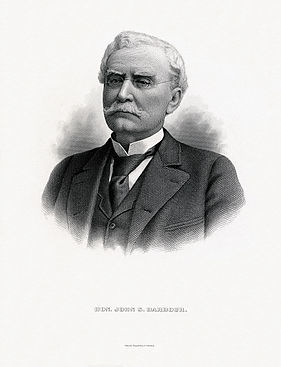 Sen. John S. Barbour, Jr. So the cavalcade of “forty or fifty” carriages with Cleveland’s in the lead took off “dashing and splashing and rushing through” downtown Charlottesville. The “whole town” was “out on the streets shouting and waving flags, handkerchiefs and hats,” Lewsley wrote. “The house fronts were completely covered with flags and bunting fluttering in the breeze.”
Sen. John S. Barbour, Jr. So the cavalcade of “forty or fifty” carriages with Cleveland’s in the lead took off “dashing and splashing and rushing through” downtown Charlottesville. The “whole town” was “out on the streets shouting and waving flags, handkerchiefs and hats,” Lewsley wrote. “The house fronts were completely covered with flags and bunting fluttering in the breeze.”Cleveland sat with Virginia Gov. Fitzhugh Lee in that first carriage, an open one “drawn by four white horses driven by a skillful black man with a footman beside him in the box.” Another important fact that Lewlsey noted: President Cleveland, a large man, and Governor Lee “together probably [weighed] about 600 pounds.”
It was a rough slog up the mountain. The road, Lewlsey—who could turn a phrase—noted, “is of clay, very red, and when wet, as it had been made by the rain that day, very tough and sticky. Pulling through a bed of putty would be lubrication itself by contrast.”
Many of the carriages didn’t make it to the top. But Cleveland’s—despite that not inconsiderable weight disadvantage—did. The first stop was Jefferson grave. It wasn’t a big hit.
For decades after Jefferson’s death visitors had vandalized his gravestone, taking dozens of chippings out of it. His family, which owned the graveyard at Monticello, began lobbying Congress in the late 1870s to build a new one. After years of wrangling, in April 1882, Congress appropriated $10,000 for a new monument over Jefferson’s grave and for other improvements to the graveyard site. A new, 18-foot granite monument was placed on Jefferson's grave that fall. Repairs were made to six other graves, a new iron fence was installed, and the entire site graded, re-seeded, and re-sodded.
The paint and gold gilding on the fence looked “quite fresh” six years later, Lewsley reported. However, everyone—including the president—decided to stay in their carriages and not make the short climb up to the graveyard.
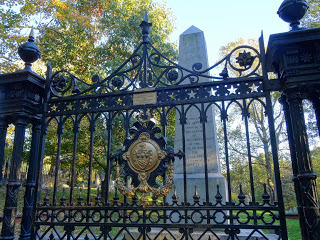
That’s because, as Lewsley put it, there “seemed to be nothing to invite them to alight.” The monument “looked cold and forbidding,” he said. The tall iron railings were “haughty, exclusive, and threatening. There did not seem to be a gate or an opening in them anywhere. There was no way to get up close without climbing up the hillside on which the grass was wet and clay soft.”
Cleveland sat in his carriage for a minute or two, and “without raising his hat or making any outward sign to show that the poetry in his soul was moving within him,” ordered the driver to move up to the hill to the house.
The entrance to the house “was guarded by two dull red brick pillars” and an iron gate, Lewsley wrote. There was a sign on an oak tree that said, “No shooting or hunting will be permitted on these grounds. Jefferson M. Levy, owner.”
Levy was on hand, along with several family members Lewsley didn’t identify, to greet the president and his party. But he only allowed those with invitations to enter the house.
Of all things, Levy had several “gray-coated State Militia” men standing with fixed bayonets outside the door to keep out the uninvited. “If anyone attempted to intrude,” Lewsley wrote, “he found a bayonet or two pointed at him.” There also was a “big Irish tiger in Levy’s livery,” Lewsley said, “who is on the ground for such service every day.”
Cleveland and company were ushered into the Parlor where Jefferson Levy and “his family” (most likely his sister Amelia Mayhoff and her husband Charles) greeted them and gave them a tour of the house.
The Levys, Lewsley noted, “try to preserve as much of the old order of things as is practicable, but the furniture and fittings have had to be somewhat modernized to meet the requirements of living to-day.”
Cleveland enjoyed his visit “immensely, taking an eager interest in what was told him by the Levys.” The last stop was a “nice new visitors’ register that had been procured for the occasion,” Lewsley wrote.
The first autograph was “Grover Cleveland, Washington, D.C.”
EVENTS: Just one event on the calendar for September, but it promises to be a memorable one. I’ll be doing a talk on Saving Monticelloat Monticello on the West Lawn on September 20. It’s the annual event for Monticello supporters. I have more events coming up in October, November, and December. Stay tuned. For info on my latest book, Ballad of the Green Beret, please go to http://bit.ly/GreenBeretBook
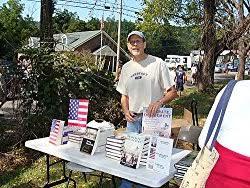
If you’d like to arrange an event for Saving Monticello—or for any of my other books, including Ballad of the Green Beret—please email me at marcleepson@gmail.com For details on other upcoming events, go to http://leepsoncalendar.blogspot.com
GIFT IDEAS: Want a personally autographed, brand-new paperback copy of Saving Monticello? Please e-mail me at marcleepson@gmail.com I also have a few as-new, unopened hardcover copies. Or go to marcleepson.com/signedbooks.html to order copies through my local bookstore, Second Chapter Books in Middleburg, Virginia. We also have copies of Desperate Engagement, Flag, and What So Proudly We Hailed, and Ballad of the Green Beret.
Published on September 06, 2018 14:33
August 6, 2018
August 2018
Saving Monticello: The NewsletterThe latest about the book, author events, and moreNewsletter Editor - Marc Leepson
Volume XV, Number 8 August 1, 2018
“The study of the past is a constantly evolving, never-ending journey of discovery.” – Eric FonerSTUDIO 360 REDUX: I distinctly remember the day in the summer of 2010 when I sat down in a small studio at WETA, the NPR station in Arlington, Virginia, put on a pair of large headphones, and began talking into a giant radio microphone about the Levys and Monticello. On the other end of the line at the studios of WNYC in New York where Studio 360 originates was the producer Amanda Aroncyzk, who had contacted me a few weeks earlier.

The interview became part of a 50-minute Studio 360 “American Icons” program that ran on October 22, 2010. It was very well well done, and I was gratified that the last ten minutes or so covered the Levy family story I told in Saving Monticello.
That section also included the words of Susan Stein, Monticello’s long-time curator, and Harley Lewis, the Levy family descendant who helped me so much when I was doing the research for the book—and a bit of clever audio reconstruction.
In the intervening eight years, Studio 360 has rebroadcast the show three or four times, most recently last month. That most-recent version included up-to-date info on Monticello’s new Sally Hemings exhibit and the Thomas Jefferson Foundation’s latest efforts to tell the story of all the enslaved people at Monticello.
You can hear the original and the latest version of the show on the Studio 360 website at http://bit.ly/Studio360Monticello
SISTER AMELIA: Twenty years ago, when I was doing the research for Saving Monticello, I spent many hours going through archival material at the Center for Jewish History at the American Jewish Historical Society in New York City. It was there that I discovered a treasure trove of primary-source material on Jefferson M. Levy: several giant scrapbooks containing letters, speeches, and scores of yellowing, crumbling newspaper clippings about that prominent New Yorker. The clips included extensive coverage of his fight to keep Monticello during the 1912-17 effort by members of Congress to take the place from him and turn it into a government-run shrine to Thomas Jefferson.
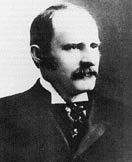 Jefferson M. LevySince then, much of that material has been digitized and some is available on the Center’s website. As I was browsing through the material the other day, I came across a newspaper clipping about Jefferson Levy’s younger sister Amelia.
Jefferson M. LevySince then, much of that material has been digitized and some is available on the Center’s website. As I was browsing through the material the other day, I came across a newspaper clipping about Jefferson Levy’s younger sister Amelia.Amelia Levy, who was born in 1858, married Carl Mayhoff, a New York City cotton broker, in 1890. The Mayhoffs lived most of the year in New York City at 66 East 34th Street, the same block where Jefferson Levy lived. Their only child, Monroe, was born in 1897.
Four years earlier, in the summer of 1893, Amelia had begun to play a not-insignifcant role in her family’s stewardship of Monticello.
As I noted in the book, after their mother’s death in January of 1893, Jefferson Levy (a life-long bachelor) asked Amelia—who used the name “von Mayhoff”—to be his hostess at Monticello, a position she relished. For the next thirty years the siblings regularly hosted long visits from friends and relatives who often arrived at Monticello with children and servants. Amelia also occasionally accompanied Jefferson Levy on his travels to Washington and to Europe.
During the seasons when she was in charge of Monticello, Amelia Mayhoff also presided over countless dinner parties, playing hostess to visiting dignitaries including President Theodore Roosevelt, ambassadors, members of Congress, and university professors, in addition to family and friends from Charlottesville, New York, and elsewhere.
Jefferson Levy left his entire estate to Amelia in a will he had executed on September 28, 1923, less than six months before he died on March 6, 1924. He wrote the will after he had agreed to sell Monticello to the newly formed Thomas Jefferson Memorial Foundation. The deal was finalized on December 1, 1923, when Jefferson Levy signed the title of Monticello over to the Foundation in New York City. Within days after her brother’s death in March Amelia announced that she would not stand in the way of the final transfer of Monticello to the Foundation.
Amelia Mayhoff lobbied in 1928 to have portraits she had inherited of her brother Jefferson Levy and her uncle Uriah Levy that had long been hung in Monticello kept on display in the house. But Fiske Kimball, who was hired to chair the Foundation’s Monticello Restoration Committee, turned down the officer.
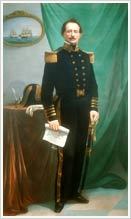
Amelia then donated the full-length Uriah Levy oil portrait to the U.S. Navy. It is on display today at the Naval Academy Museum in Annapolis. She presented the life-sized oil painting of Jefferson Levy to the New York Democratic Club. Jefferson Levy was one of that New York City organization’s founders
EVENTS: Taking a rare break from speaking events in August, but have plenty scheduled for the fall. Stay tuned. Meanwhile, for info on my latest book, Ballad of the Green Beret, please go to http://bit.ly/GreenBeretBook
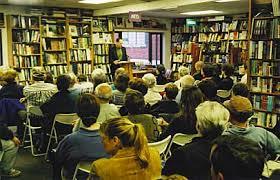
If you’d like to arrange an event for Saving Monticello—or for any of my other books, including Ballad of the Green Beret—please email me at marcleepson@gmail.com For details on other upcoming events, go to http://leepsoncalendar.blogspot.com
GIFT IDEAS: Want a personally autographed, brand-new paperback copy of Saving Monticello? Please e-mail me at marcleepson@gmail.com I also have a few as-new, unopened hardcover copies. Or go to marcleepson.com/signedbooks.html to order copies through my local bookstore, Second Chapter Books in Middleburg, Virginia. We also have copies of Desperate Engagement, Flag, and What So Proudly We Hailed, and Ballad of the Green Beret.
Published on August 06, 2018 09:55
July 4, 2018
July 2018
Saving Monticello: The NewsletterThe latest about the book, author events, and moreNewsletter Editor - Marc Leepson
Volume XV, Number 7 July 1, 2018
"The study of the past is a constantly evolving, never-ending journey of discovery." - Eric Foner
CREATED EQUAL: The headlines tell the story: “Monticello is Done Avoiding Jefferson’s Relationship with Sally Hemings”—New York Times“Sally Hemings Gets Her Recognition at Monticello”—Washington Post “Sally Hemings Takes Center Stage”—New York Times op ed. by Annette Gordon-Reed
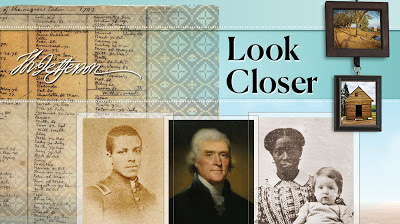
The news that those headlines heralded was the June 16 ceremony marking the opening of a new exhibition at Monticello devoted to the life of Sally Hemings and other members of her family.It is located in a room along the south wing of the house that archeologists and historians believe was once inhabited by Hemings. That room, formerly a public bathroom, has been restored to what it most likely looked like when Sally Hemings was alive.
“Symbolically and emotionally, the restoration of the Hemings room is the heart of the new interpretation of Monticello,” Washington Post architecture critic Philip Kennicott wrote, “and it makes tangible a relationship that has been controversial since rumors of ‘Dusky Sally’ became part of the American political landscape in the early 19th century.”
Visitors to Monticello “will for the first time see Sally Hemings depicted as a central figure in life on the mountain,” Gordon-Reed, the author of The Hemingses of Monticellowho spoke at the ceremonies, wrote. “This is a remarkable turn of events. For centuries, historians denied Jefferson’s relationship with Sally Hemings. This exhibit has been a long time coming, but better late than never.”
Some three hundred descendants of enslaved people who labored at Monticello were among the crowd that day, June 16, 2018—a day “that will go down go down in Monticello’s history,” as Leslie Bowman, the Thomas Jefferson’s Foundation’s President, put it in her opening remarks.

There’s an excellent on-line version of the Sally Hemings exhibit at http://bit.ly/HemingsExhibit
The Thomas Jefferson Foundation has videos of the entire June 16 opening ceremonies—including remarks by Bowman, Gordon-Reed, and Monticello benefactor David Rubenstein—on its website at http://bit.ly/June16Ceremonies
R12 AT THE LEVY CENTER: That’s U.S. Naval Academy speak for the position held by Lt. Steven Ballaban, who in January was named the 12th rabbi assigned to the Academy. Rabbi Ballaban holds a BA in English Literature from Vassar, along with an MA in Hebrew Letters, and an MA and a PhD in Philosophy from Hebrew Union College in Cincinnati. He received his rabbinical ordination in 1986, after which he went on active duty in the Navy. He later served in the Navy Reserve and in 2014 was commissioned as a chaplain. He previously served as Staff Chaplain at the Naval Air Facility in Atsugi in Japan.
How does this relate to Saving Monticello? Rabbi Ballaban, as the Naval Academy’s rabbi, is the spiritual leader of the Commodore Uriah P. Levy Center and the Esther and William Miller Jewish Chapel (in photo below). The Center and Chapel were dedicated in September of 2005 adjacent to Bancroft Hall, the gigantic building where all 4,000 Midshipmen live and eat their meals.
The architect included a dome on the entrance in honor of Uriah Levy’s stewardship of Monticello, which he owned from 1834 to his death in 1862, and which he repaired, restored, and preserved.

EVENTS: Here’s a rundown on my July speaking events. For info on my latest book, Ballad of the Green Beret, please go to http://bit.ly/GreenBeretBook· Tuesday, July 3 – Talk on Ballad of the Green Beret and book signing at The Glebe retirement community, Daleville, Virginia
· Thursday, July 26 – Talk on Ballad and book signing at Vietnam Veterans of America’s National Leadership & Education Conference, Palm Springs, California
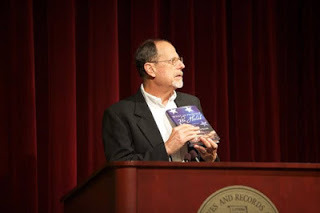
If you’d like to arrange an event for Saving Monticello—or for any of my other books, including Ballad of the Green Beret—please email me at marcleepson@gmail.com For details on other upcoming events, go to http://leepsoncalendar.blogspot.com
GIFT IDEAS: Want a personally autographed, brand-new paperback copy of Saving Monticello? Please e-mail me at marcleepson@gmail.com I also have a few as-new, unopened hardcover copies.
Or go to marcleepson.com/signedbooks.html to order copies through my local bookstore, Second Chapter Books in Middleburg, Virginia. We also have copies of Desperate Engagement, Flag, and What So Proudly We Hailed, and Ballad of the Green Beret.
Published on July 04, 2018 08:32
June 4, 2018
June 2018
Saving Monticello: The NewsletterThe latest about the book, author events, and moreNewsletter Editor - Marc LeepsonVolume XV, Number 6 June 1, 2018“The study of the past is a constantly evolving, never-ending journey of discovery.” – Eric Foner
JOHN LOCKE IS BACK: Most readers of this newsletter know that when Thomas Jefferson died (on July 4, 1826), he left his family with a huge debt: more than $107,000. That forced his heirs—his daughter Martha Randolph and her son Thomas Jefferson Randolph—to sell virtually all of Monticello’s furniture and furnishings (as well as his enslaved people)—and eventually Monticello itself.
That sad state of affairs is an integral part of Saving Monticello and I cover it in detail in the book. As I wrote, the Randolphs held a sale on the mountain on January 15, 1827, that lasted five days. There is no complete record of who bought the items, but family letters reveal that Jefferson’s grandchildren purchased most of the furniture and furnishings. Jefferson’s art works (including sixty-three paintings) and books were not part of the January 1827 auction.
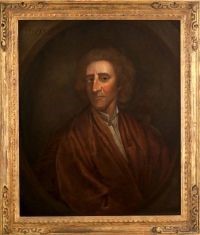
The family decided to market the paintings and other works of art in Boston, where they thought the collection would bring better prices than in Charlottesville. They held a sale at the Boston Athenaeum in July 1828 with disappointing results. A second sale took place five years later, on July 19, 1833. It was an auction at Harding’s Gallery in Boston. Again, the results were disappointing; only a few paintings were sold.
I didn’t go into detail in the book about where the paintings went or what they sold for. But I’ve since learned that an unidentified buyer bought a portrait (for $35) that Jefferson owned of the famed Enlightenment philosopher John Locke. That painting—a copy of one from the Royal Society in London, which Jefferson purchased in 1789—had hung in the upper tier of the Parlor at Monticello in a group with Francis Bacon and Isaac Newton. Jefferson called them “my trinity of the three greatest men the world had ever produced.”
Sometime after 1833, the Locke portrait made its way to Harvard University. In 1959, Harvard donated the painting was given to the Thomas Jefferson Foundation and it was restored to its place in the Parlor.
Flash forward to a few years ago. A group of visitors touring Monticello noticed that the Locke painting was in not-great condition. Inquiries were made. The visitors then generously decided to donate the funds to have it conserved. To do the work, Monticello hired Scott Nolley, who runs Fine Art Conservation of Virginia.
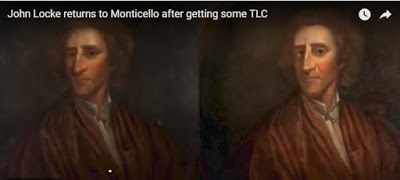
Before After In a short, but fascinating video, Nolley, Monticello Assistant Curator Emilie Johnson, and Monticello Museum Technician Caitlin Hepner explain the complex process of getting the painting back to its original 18th century condition. It involved a “reversal,” and much in-repainting and retouching.
The before-and-after images are from the page on the Monticello web site that includes the video. Take a look: http://bit.ly/2LockePainting
EVENTS: Here’s a rundown on my June speaking events. For info on my latest book, Ballad of the Green Beret, please go to http://bit.ly/GreenBeretBook· Saturday, June 9 – Talk on Flag: An American Biography and book signing at the Maryland DAR Chapter Regents Club Luncheon, Chevy Chase, Maryland· Saturday, June 16 – Talk on Ballad and book signing for the Mount Vernon Chapter of the Military Officers Association of America, Alexandria, Virginia· Thursday, June 21 – Talk on Flag and book signing for Washington (D.C.) Metro Oasis (Life-Long Learning), Bethesda, Maryland. For info and reservations, call 301-469-6800· Saturday, June 23 - Virginia Chapter of the Sons and Daughters of the Pilgrims, Charlottesville, Virginia· Tuesday, June 26 – Talk on Saving Monticello and book signing for the Augustus P. Gardner American Legion Post, McLean, Virginia

If you’d like to arrange an event for Saving Monticello—or for any of my other books, including Ballad of the Green Beret—please email me at marc527psc@aol.com
For details on other upcoming events, go to http://leepsoncalendar.blogspot.com
GIFT IDEAS: Want a personally autographed, brand-new paperback copy of Saving Monticello? Please e-mail me at marcleepson@gmail.com I also have a few as-new, unopened hardcover copies. Or go to marcleepson.com/signedbooks.html to order copies through my local bookstore, Second Chapter Books in Middleburg, Virginia. We also have copies of Desperate Engagement, Flag, and What So Proudly We Hailed, and Ballad of the Green Beret.
Published on June 04, 2018 09:50
May 4, 2018
May 2018
Saving Monticello: The NewsletterThe latest about the book, author events, and moreNewsletter Editor - Marc LeepsonVolume XV, Number 5 May 1, 2018“The study of the past is a constantly evolving, never-ending journey of discovery.” – Eric FonerMYSTERY SOLVED: Readers of this newsletter may remember that we have written several times over the years about the fate of the “Levy Lions,” the four statues that Jefferson Levy had arrayed at Monticello. The lions—which were pictured oin the engraving of Monticello that was on the back of the $2 bill from 1929-1976—were sold after the Thomas Jefferson Foundation bought Monticello from Levy in 1923 and disposed of all of its non-Jefferson contents.
Decades later, we learned that two of the lions made their way to Cheekwood Gardens in Nashville. But the fate of the other two remained unknown. Until now.
Rebecca English, who lives near Charlottesville, started a quest to find the two missing Levy Lions after she thought she spotted one outside a house not far from Monticello nearly five years ago. She first wrote about that on her excellent Forsythia Hill blog in December of 2013.
In that and subsequent posts Rebecca reported on her progress (or lack thereof) trying to track down the missing lions. Then early this year she hit pay dirt. She discovered the lions at a historic home listed for sale in Hendersonville, North Carolina, near Asheville.
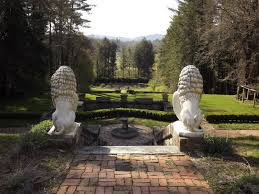
“I knew the second I saw the lions that they were authentic,” Rebecca writes in her blog. She did some close side-by-side comparisons of photos of the lions from the late 19th and early 20thcentury at Monticello and shots of the ones in North Carolina. The only discrepancy Rebecca found was “time and wear,” she wrote. “The lions are missing a few teeth but everything else matches up!”
The Levy Lions sit regally on the rear terrace (see photo above) of a historic house called Chanteloup, which was built in 1840 for a French count and countess on 28 acres of land and sometimes is known as “Little Biltmore.” In 1900 new owners brought in the pioneering landscape architect Frederick Law Olmsted to design the terraced gardens.
Rebecca drove to Hendersonville to confirm what she suspected. “Not only was the trip to see the lions amazing,” she wrote, “but the property owners celebrated this event with us by providing lunch on the veranda. I could gaze upon the lions and the Olmsted gardens and watch the birds dip and dive down in the valley below.”
Below are photos Rebecca took and kindly gave us permission to use of the lions at Chanteloup.You can read her entire post at http://bit.ly/LevyLionsFound
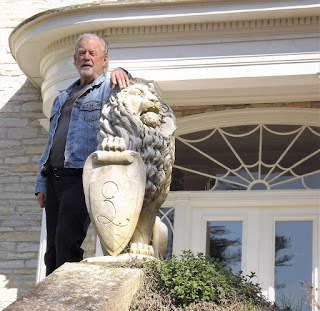
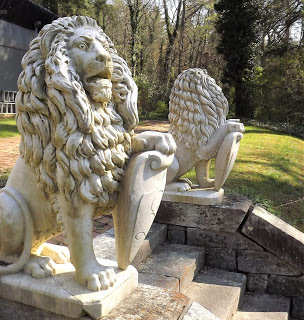
EVENTS: Here’s a rundown on my May speaking events. For info on my latest book, Ballad of the Green Beret, please go to http://bit.ly/GBBallad· Tuesday, May 1– Talk on Ballad of the Green Beret and book signing for the Veterans Military History Group at the Silver Spring (Maryland) Senior Center.· Saturday, May 5 – Talk on Ballad for the Lane’s Mill DAR Chapter and book signing at monthly meeting in Centreville, Virginia· Monday, May 14 – Talk on What So Proudly We Hailed: Francis Scott Key, A Life for the Chasseur Chapter of the United Daughters of 1812, Sandy Spring, Maryland.· Tuesday, May 15 – Talk on Francis Scott Key, the “The Star-Spangled Banner,” and the history of the American flag at the JCC of Northern Virginia, 8900 Little River Turnpike, Fairfax. More info at http://bit.ly/JCCFlag· Saturday, May 19 – Moderator of a 9:30 a.m. panel on Vietnam War Biography at the annual Biographers International Organization (BIO) Conference, at the CUNY Graduate Center in New York City. For more info and to register go to https://www.regonline.com/2018BIOconference
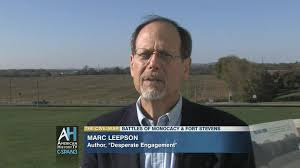
If you’d like to arrange an event for Saving Monticello—or for any of my other books, including Ballad of the Green Beret—please email me at marc527psc@aol.comFor details on other upcoming events, go to http://leepsoncalendar.blogspot.com
GIFT IDEAS: Want a personally autographed, brand-new paperback copy of Saving Monticello? Please e-mail me at marcleepson@gmail.com I also have a few as-new, unopened hardcover copies. Or go to marcleepson.com/signedbooks.html to order copies through my local bookstore, Second Chapter Books in Middleburg, Virginia. We also have copies of Desperate Engagement, Flag, and What So Proudly We Hailed, and Ballad of the Green Beret.
https://www.regonline.com/2018BIOconference
Published on May 04, 2018 12:53
April 3, 2018
April 2018
Saving Monticello: The NewsletterThe latest about the book, author events, and moreNewsletter Editor - Marc LeepsonVolume XV, Number 4 April 1, 2018“The study of the past is a constantly evolving, never-ending journey of discovery.” – Eric FonerJEWS OF C’VILLE: Virtually every large and mid-sized city in the American South has had significant Jewish communities since the mid-19th century. Charlottesville, Virginia—the home of Thomas Jefferson, the University of Virginia, and Monticello (owned by the Levy family from 1834-1923)—is no exception.
That was the point of a March 18 walking tour of C’ville led by long-time U-Va. History Professor Phyllis Leffler. During the tour Prof. Leffler looked at the Jewish families and businesses in that Central Virginia city, including U.S. Navy Lt. Uriah Levy (who was born in Philadelphia in 1792), who purchased Monticello in 1834.
Professor Leffler has had a long interest in the Jews of Charlottesville. In the mid-1990s she and U-Va. Anthropology Prof. Jeff Hantman were the driving forces behind an extensive exhibit at U-Va.’s Alderman Library called “To Seek the Peace of City,” which took an in-depth look at the picture. The title comes from Jeremiah 29.7: “And seek the peace of the city whither I have caused you to be carried away ... for in the peace thereof shall ye have peace.”
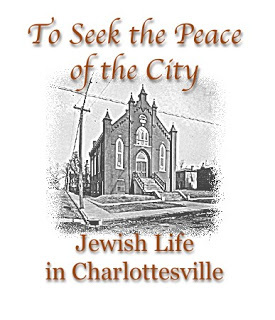
That exhibit lives today in an extensive on-line presence at http://bit.ly/SeekthePeaceIt tells the “story of colonial era Sephardic Jews and of nineteenth century immigrants first from Bavaria and Wurttemberg and then from Kovno and Minsk. It is a story of peddlers and merchants, and of involvement and leadership in local government, the arts and education. It is a story of the commitment of a few to the creation and maintenance of local civic and religious institutions.”“To Seek the Peace of the City” is an expansion of a 1993 U-Va. exhibit, “Jewish Life at Mr. Jefferson's University,” which was presented as part of the University’s commemoration of Thomas Jefferson’s 250th birthday. On the March tour, Leffler explained that there were Jews in the city “from the earliest, pre-Revolutionary period.” But, “like many small towns there weren’t enough to constitute a community. Before the 1870s, there weren’t enough Jews to build anything.” She went on to point out that Charlottesville “was a tiny, tiny town, but for merchants and itinerant travelers, it was a location that made sense west of Richmond and on the trade route between Baltimore and Lynchburg. It was good spot for merchants to get established.”Most of the merchants, she said, operated along what is now C’ville’s downtown mall, where they owned “shoe shops, department stores, and restaurants. “They [also] served on school, city and community boards,” she said. “They were remarkably integrated into the life of Charlottesville. As prominent merchant families, they all really took a role in the city and making it work.” (Here’s a like to the Charlottesville Daily Progress article on the tour in the: http://bit.ly/Cvillearticle)
Leffler included Uriah Levy’s nephew Jefferson Levy in her tour, as he spent considerable time in Charlottesville after buying out his uncle’s other heirs and taking control of Monticello in 1879. A committed real estate and stock speculator, Jefferson Levy (who sold Monticello to the Thomas Jefferson Foundation in 1923) bought and sold a good number of other properties in C’ville.As I noted in Saving Monticello, his first significant purchase in the city came in 1887 when he bought a building at the corner of Park and High Streets known as the Town Hall, which had been built in 1852. Town Hall, a large, three-story Georgian style brick structure, was used as a gathering place for local groups, traveling speakers and touring theatrical companies. By the mid-1880s, though, it had fallen into disuse.
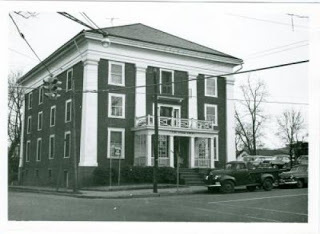
Jefferson Levy remodeled Town Hall and in 1888 renamed it the Levy Opera House. He enlarged the stage and put in a new orchestra pit with dressing rooms below it, inclined the floor to improve sight lines and installed a horseshoe-shaped gallery, new opera chairs and two boxes on the sides of the stage.
The Levy Opera House hosted the first symphony orchestra that played in Charlottesville, the Boston Symphony, which came to town in 1891. That year Jefferson Levy leased the Opera House to Jacob (“Jake”) Leterman and Ernest Oberdorfer, sons of the founders of Charlottesville's German Reform synagogue. Leterman and Oberdorfer brought in other symphony orchestras, minstrel shows and various types of theatrical productions.
In 1907, Levy leased the building to the Jefferson School for Boys, a small boarding and day prep school, for $400 a year. An addendum to the lease stipulated that if any theatrical performances were given in the Opera House, it “shall be advertised as the Levy Opera House,” and that Jefferson Levy retained the right to his box there. The school moved out in 1912. Two years later Levy sold the building, and it was subdivided into apartments. Today it has been remodeled into office space and is still known as the Levy Opera House.

EVENTS: Here’s a rundown on my ten April speaking events. It’s one of the busiest months—if not the busiest—in my seventeen years of doing talks for my books. Five of the talks are on Saving Monticello. For info on my new book, Ballad of the Green Beret, please go to http://bit.ly/GBBallad· Friday, April 6 – Talk on Francis Scott Key and the writing of “The Star-Spangled Banner” and book signing for the Daughters of 1812 Association of State Presidents annual banquet in Washington, D.C.
· Tuesday, April 10 - Talk on Saving Monticelloand book signing at the ExxonMobil Spouses Club luncheon in Great Falls, Virginia.
· Tuesday, April 10 – Talk on The Civil War Battle of Monocacy based on my book, Desperate Engagement, for the Southern Maryland Civil War Roundtable at the College of Southern Maryland in LaPlata, Md. For info, go to http://somdcwrt.org
· Wednesday, April 11 – Talk on Saving Monticelloand book signing at the monthly meeting of the Arlington House DAR Chapter, Arlington, Virginia.
· Thursday, April 12 – Talk on Saving Monticelloand book signing for the National Society of Colonial Dames XVII Century National Conference, Washington, D.C.
· Friday, April 13 – Talk on Saving Monticelloand book signing at the Annual Meeting of Presidential Families of America, Washington, D.C.
· Saturday, April 14 – Field trip at the Monocacy National Battlefield Park for the Southern Maryland Civil War Round Table, Frederick, Maryland.
· Sunday, April 15 – Talk on Flag: An American Biography at the annual meeting of the Daughters of the Barons of Runnemede, Washington, D.C.
· Friday, April 27 – 2:45 p.m. talk on Desperate Engagement and book signing at the Shenandoah Valley Battlefields Foundation’s 2018 National Civil War Conference, “Avenue of Invasion” (9:00 a.m. – 4:30 p.m.) in Martinsburg, West Virginia. Open to the public. For more info and to register, go to http://www.shenandoahatwar.org/avenue-of-invasion
· Friday, April 27 – 6:00 p.m. talk on Saving Monticello at the “Eat, Drink, Be Literary” event sponsored by the Hillsboro Historic Old Stone School in Hillsboro, Virginia. A fundraising event open to the public. For info email events@oldstoneschool.orgor call 540-486-8001.
If you’d like to arrange an event for Saving Monticello—or for any of my other books, including Ballad of the Green Beret—please email me at marc527psc@aol.comFor details on other upcoming events, go to http://leepsoncalendar.blogspot.com
GIFT IDEAS: Want a personally autographed, brand-new paperback copy of Saving Monticello? Please e-mail me at marcleepson@gmail.com I also have a few as-new, unopened hardcover copies. Or go to marcleepson.com/signedbooks.html to order copies through my local bookstore, Second Chapter Books in Middleburg, Virginia. We also have copies of Desperate Engagement, Flag, Lafayette, and What So Proudly We Hailed, and Ballad of the Green Beret.
Published on April 03, 2018 15:15
March 6, 2018
March 2018
Saving Monticello: The NewsletterThe latest about the book, author events, and moreNewsletter Editor - Marc LeepsonVolume XV, Number 3 March 1, 2018
“The study of the past is a constantly evolving, never-ending journey of discovery.” – Eric Foner
THE CLOCK (CON’T.) In the January SM Newsletter I wrote about the time in December of 1937 when a Richmond jeweler named Otto Frederick Ostergren was hired to repair Thomas Jefferson’s famed seven-day clock, which has graced the Monticello Entrance Hall since 1805. The problem was that the clock hadn’t been working properly since the 1850s when Uriah Levy owned the place.
To do the repair work, Ostergren had to remove the clock from the premises, and take it to his workshop. So that day in December 70-plus years ago, Mr. Ostergren showed up at Monticello and with the help of an assistant, took the clock down and carefully loaded it into the trunk of his car and then drove off to Richmond.
Bill Bergen, the dean of the tour guides at Monticello—and a subscriber to this newsletter—emailed me after he received it and sent along an image of a photo I’d never seen. It’s an evocative (and to my mind, historic) picture of Ostergren and his assistant gently placing the clock into the trunk of his car. Thanks to Bill for digging in out; to Jack Robertson, the Foundation Librarian at Monticello’s Jefferson Library, for discovering its provenance; and to the Library of Virginia for giving me permission to reprint it here:
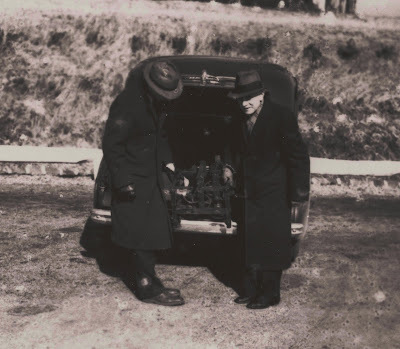
THE MEDALS: The University of Virginia and Monticello will award three Thomas Jefferson Foundation Medals—the highest external honors U-Va. (which does not award honorary degrees) bestows—on April 13, Thomas Jefferson’s birthday.
The Medal in Architecture will go to David Adjaye, a world-renowned architect best known for his innovative sculptural designs, including the Smithsonian Institution’s National Museum of African American History and Culture on the Mall in Washington, D.C. Adjaye, who was born in Tanzania, was recently knighted last year by Queen Elizabeth for his architectural work, and was named one of the 100 most influential people by TIME magazine. His website is http://www.adjaye.com
The Medal in Citizen Leadership will go to Morgan Carrington “Cary” Fowler Jr., an agriculturalist and the former executive director of the Crop Trust. He has worked for decades on crop diversity and conservation. Fowler founded the Svalbard Global Seed Vault, a heavily fortified seed bank located on the Norwegian island of Spitsbergen in the Arctic Svalbard Archipelago some 1,300 miles from the North Pole. It’s the world’s largest collection of crop diversity, and holds more than 930,000 distinct varieties.
The Medal in Law will go to Frank H. Easterbrook, a judge on the U.S. Court of Appeals for the 7th Circuit, senior lecturer at the University of Chicago Law School, and former Department of Justice official who specializes in antitrust, criminal and corporate law.
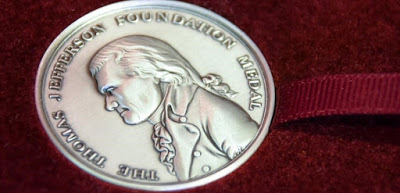 The Medal“Thomas Jefferson was an essential architect of American life. A philosopher, revolutionary, president, scientist, diplomat, educator, farmer and epicure, Jefferson shaped the new nation,” said Leslie Greene Bowman, the president and CEO of the Foundation. “We are honored to welcome the 2018 Thomas Jefferson Foundation Medal recipients, each of whom, like Jefferson, has made a profound impact on our world and will inspire future generations of leaders.”
The Medal“Thomas Jefferson was an essential architect of American life. A philosopher, revolutionary, president, scientist, diplomat, educator, farmer and epicure, Jefferson shaped the new nation,” said Leslie Greene Bowman, the president and CEO of the Foundation. “We are honored to welcome the 2018 Thomas Jefferson Foundation Medal recipients, each of whom, like Jefferson, has made a profound impact on our world and will inspire future generations of leaders.”The ceremonies on April 13 include free public lectures at U-Va. by the medal recipients, a formal dinner at Monticello and a luncheon in the Dome Room of the Thomas Jefferson-designed Rotunda on the U-Va. grounds. Details at this page on Monticello's website.
VOLUNTEER OPPORTUNITY: According to a recent announcement in the Charlottesville Daily Progress, The Thomas Jefferson Foundation, the good folks who own and operate Monticello, are looking for volunteers to work at the Monticello Visitor Center (pictured below). For more info, email volunteer@monticello.org or call 434-984-9869.
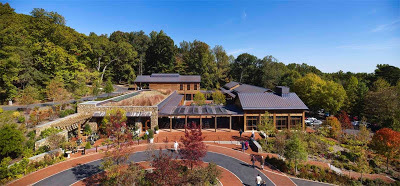
EVENTS: Here’s a rundown on my March speaking events. For info on my new book, Ballad of the Green Beret, please go to http://bit.ly/GBBallad· Monday, March 12 – Talk on Saving Monticello and book signing for the Anna Maria Fitzhugh DAR Chapter in Alexandria, Virginia· Thursday, March 29 - Talk on Ballad of the Green Beret for the Rotary Club of Purcellville in Purcellville, Virginia
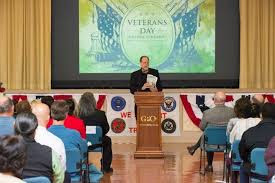
If you’d like to arrange an event for Saving Monticello—or for any of my other books, including Ballad of the Green Beret—please email me at marc527psc@aol.com
For details on other upcoming events, go to http://leepsoncalendar.blogspot.com
GIFT IDEAS: Want a personally autographed, brand-new paperback copy of Saving Monticello? Please e-mail me at Marc527psc@aol.com I also have a few as-new, unopened hardcover copies.
Or go to marcleepson.com/signedbooks.html to order copies through my local bookstore, Second Chapter Books in Middleburg, Virginia. We also have copies of Desperate Engagement, Flag, Lafayette, and What So Proudly We Hailed, and Ballad of the Green Beret.
Published on March 06, 2018 12:25
February 3, 2018
February 2018
Saving Monticello: The NewsletterThe latest about the book, author events, and moreNewsletter Editor - Marc LeepsonVolume XV, Number 2 February 1, 2018
“The study of the past is a constantly evolving, never-ending journey of discovery.” – Eric Foner
THE KITCHEN: The latest archaeological news at Monticello came late last year when a dig in the South Pavilion cellar discovered portions of several stoves used by Jefferson’s enslaved French-trained chef James Hemings.
An excellent, well-illustrated article in Live Science (http://bit.ly/MontKitchen) reveals what happened when researchers started digging in a space in the cellar that had been used as a visitors’ bathroom for more than fifty years before the Thomas Jefferson Foundation decided to restore the cellar to what it was in Jefferson’s time.
The article notes that the archaeological team also found a trove of other artifacts, including pottery and glass bottle fragments, animal bones, and toothbrushes, along with the original brick kitchen floor, and pieces of the fireplace and four stew stoves.

The photo above, from the Thomas Jefferson Foundation, shows the recreated stew stoves.James Hemings, who was born in 1765, was among the scores of slaves owned by Thomas Jefferson’s father-in-law John Wayles. James’ mother was Elizabeth (Betty) Hemings. It’s all but certain that John Wayles was his father—as well as the father of all of James Hemings’ five full siblings, including his younger sister Sally. That meant that those Hemings siblings also were Thomas Jefferson’s wife Martha’s half brothers and sisters.
Jefferson took James (and Sally) Hemings to Paris in August of 1784, when he served as U.S. Minister (Ambassador) to France, which is where James learned to cook. He was freed by Jefferson in 1796, seven years after they returned from France.
I do not mention James Hemings in Saving Monticello, as he had left Monticello well before the story I tell begins—and he died in 1801. Nor do I mention his famed younger sister Sally Hemings for the same reason. The only time the name “Hemings” comes up in my book is when I discuss Thomas Jefferson’s death in 1826 and his will.
In it, Jefferson left his walking staff to James Madison. He gave watches to each of his grandchildren, and donated his books to the University of Virginia—although they later were sold, instead, to raise cash.
A codicil in the will granted freedom to five of Monticello’s enslaved people who had learned trades, all of whom were members of the Hemings family: Joe Fossett, Burwell Culbert, and John, Madison and Eston Hemings. Burwell Culbert, who was Jefferson’s butler and main household servant, also received $300. All five newly free men were also given houses.
For more info on James Hemings, take a look at the Foundation’s excellent sketch of his life at http://bit.ly/2JamesHemings
HIS THREE DAUGHTERS: Another member of the Hemings family is one of the three women profiled in the just-published book, Jefferson’s Daughters: Three Sisters, White and Black in a Young America (Ballantine Books, 425 pp. $28, by Katherine Kerrison, a Villanova University U.S. History Professor.

The book is a combined biography of Thomas and Martha Jefferson’s two daughters, Martha, whom Jefferson called “Patsy” (1772-1836), and Maria (1778-1804), known as “Polly”—along with Kerrison’s reconstruction of the life of Harriet Hemings, who was born in 1801, the daughter of Sally Hemings and Thomas Jefferson. The Thomas Jefferson Foundation and most historians believe that Jefferson and Sally Hemings had a total of six children following the death of his wife Martha in 1782. Harriet was the eldest.
Harriet Hemings was given her freedom at age 21. She left Monticello, and moved to Washington, D.C. in 1822, four years before Jefferson’s death. She never saw her mother or father after that.
According to Kerrison’s book, Harriet Hemings (who was seven-eighths white) married a white man in Washington and had several children. She and her children lived as white people.
Kerrison’s life stories of Martha and Maria, Jefferson’s white daughters, includes their time with him in Paris where fourteen-year-old Sally Hemings served as Maria’s companion. You can read the New York Times review of the book by Mary Beth Norton at http://bit.ly/DaughtersReview and Kerrison’s recent essay on the topic in the Washington Post at http://bit.ly/JeffDaughters
EVENTS: Here’s a rundown on my February speaking events. For info on my new book, Ballad of the Green Beret, please go to http://bit.ly/GBBallad· Saturday, February 10 – Talk on Saving Monticello and book signing for the Oak Hill Chapter of the U.S. Daughters of 1812 in McLean, Virginia· Sunday, February 25 - Talk on Ballad of the Green Beret for the Mayflower Society of Washington, D.C., in Vienna, Virginia

If you’d like to arrange an event for Saving Monticello—or for any of my other books, including Ballad of the Green Beret—please email me at marc527psc@aol.com
For details on other upcoming events, go to http://leepsoncalendar.blogspot.com
GIFT IDEAS: Want a personally autographed, brand-new paperback copy of Saving Monticello? Please e-mail me at Marc527psc@aol.com I also have a few as-new, unopened hardcover copies. Or go to marcleepson.com/signedbooks.html to order copies through my local bookstore, Second Chapter Books in Middleburg, Virginia. We also have copies of Desperate Engagement, Flag, Lafayette, and What So Proudly We Hailed, and Ballad of the Green Beret.
“The study of the past is a constantly evolving, never-ending journey of discovery.” – Eric Foner
THE KITCHEN: The latest archaeological news at Monticello came late last year when a dig in the South Pavilion cellar discovered portions of several stoves used by Jefferson’s enslaved French-trained chef James Hemings.
An excellent, well-illustrated article in Live Science (http://bit.ly/MontKitchen) reveals what happened when researchers started digging in a space in the cellar that had been used as a visitors’ bathroom for more than fifty years before the Thomas Jefferson Foundation decided to restore the cellar to what it was in Jefferson’s time.
The article notes that the archaeological team also found a trove of other artifacts, including pottery and glass bottle fragments, animal bones, and toothbrushes, along with the original brick kitchen floor, and pieces of the fireplace and four stew stoves.

The photo above, from the Thomas Jefferson Foundation, shows the recreated stew stoves.James Hemings, who was born in 1765, was among the scores of slaves owned by Thomas Jefferson’s father-in-law John Wayles. James’ mother was Elizabeth (Betty) Hemings. It’s all but certain that John Wayles was his father—as well as the father of all of James Hemings’ five full siblings, including his younger sister Sally. That meant that those Hemings siblings also were Thomas Jefferson’s wife Martha’s half brothers and sisters.
Jefferson took James (and Sally) Hemings to Paris in August of 1784, when he served as U.S. Minister (Ambassador) to France, which is where James learned to cook. He was freed by Jefferson in 1796, seven years after they returned from France.
I do not mention James Hemings in Saving Monticello, as he had left Monticello well before the story I tell begins—and he died in 1801. Nor do I mention his famed younger sister Sally Hemings for the same reason. The only time the name “Hemings” comes up in my book is when I discuss Thomas Jefferson’s death in 1826 and his will.
In it, Jefferson left his walking staff to James Madison. He gave watches to each of his grandchildren, and donated his books to the University of Virginia—although they later were sold, instead, to raise cash.
A codicil in the will granted freedom to five of Monticello’s enslaved people who had learned trades, all of whom were members of the Hemings family: Joe Fossett, Burwell Culbert, and John, Madison and Eston Hemings. Burwell Culbert, who was Jefferson’s butler and main household servant, also received $300. All five newly free men were also given houses.
For more info on James Hemings, take a look at the Foundation’s excellent sketch of his life at http://bit.ly/2JamesHemings
HIS THREE DAUGHTERS: Another member of the Hemings family is one of the three women profiled in the just-published book, Jefferson’s Daughters: Three Sisters, White and Black in a Young America (Ballantine Books, 425 pp. $28, by Katherine Kerrison, a Villanova University U.S. History Professor.

The book is a combined biography of Thomas and Martha Jefferson’s two daughters, Martha, whom Jefferson called “Patsy” (1772-1836), and Maria (1778-1804), known as “Polly”—along with Kerrison’s reconstruction of the life of Harriet Hemings, who was born in 1801, the daughter of Sally Hemings and Thomas Jefferson. The Thomas Jefferson Foundation and most historians believe that Jefferson and Sally Hemings had a total of six children following the death of his wife Martha in 1782. Harriet was the eldest.
Harriet Hemings was given her freedom at age 21. She left Monticello, and moved to Washington, D.C. in 1822, four years before Jefferson’s death. She never saw her mother or father after that.
According to Kerrison’s book, Harriet Hemings (who was seven-eighths white) married a white man in Washington and had several children. She and her children lived as white people.
Kerrison’s life stories of Martha and Maria, Jefferson’s white daughters, includes their time with him in Paris where fourteen-year-old Sally Hemings served as Maria’s companion. You can read the New York Times review of the book by Mary Beth Norton at http://bit.ly/DaughtersReview and Kerrison’s recent essay on the topic in the Washington Post at http://bit.ly/JeffDaughters
EVENTS: Here’s a rundown on my February speaking events. For info on my new book, Ballad of the Green Beret, please go to http://bit.ly/GBBallad· Saturday, February 10 – Talk on Saving Monticello and book signing for the Oak Hill Chapter of the U.S. Daughters of 1812 in McLean, Virginia· Sunday, February 25 - Talk on Ballad of the Green Beret for the Mayflower Society of Washington, D.C., in Vienna, Virginia

If you’d like to arrange an event for Saving Monticello—or for any of my other books, including Ballad of the Green Beret—please email me at marc527psc@aol.com
For details on other upcoming events, go to http://leepsoncalendar.blogspot.com
GIFT IDEAS: Want a personally autographed, brand-new paperback copy of Saving Monticello? Please e-mail me at Marc527psc@aol.com I also have a few as-new, unopened hardcover copies. Or go to marcleepson.com/signedbooks.html to order copies through my local bookstore, Second Chapter Books in Middleburg, Virginia. We also have copies of Desperate Engagement, Flag, Lafayette, and What So Proudly We Hailed, and Ballad of the Green Beret.
Published on February 03, 2018 13:42



